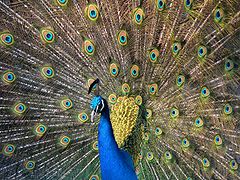Ornament (behavioral biology)

In behavioral biology, ornament is the sexually selected body features of living beings that play a role in courtship . These are colors, patterns, attachments, enlarged structures or other complex signals that play a role in the mating competition. Behavioral biology knows not only visual ornaments, but also acoustic and olfactory ones.
According to a widespread hypothesis, the so-called handicap hypothesis , these conspicuous ornaments represent an indicator of the physical fitness of the wearer. The handicap hypothesis is based on the fact that the ornament reduces the wearer's chance of survival or increases the risk of predation , because it thereby increases becomes more noticeable for predators. The wearer of the ornament is only able to overcome this handicap due to good physical fitness.
Visual ornaments

One of the most frequently cited examples of an ornament is the long tail of the blue peacock . Wearing such a tail makes the peacock conspicuous for predators and prevents it in its flight; the same applies to birds of paradise . Visual ornaments are also found in many other animal families and orders. In lions, for example, a dark, thick mane signals physical fitness, as this can only be developed long and dense with a good hormone status and adequate nutrition. The formation of the mane also varies in a single individual in the course of life. From field studies in which stuffed male lions were used, it is known that females react positively to males with dark, strong manes, while males tend to avoid such competitors. In doing so, this visual ornament helps avoid risky fights. The price of the dark mane, however, is increased heat stress .
Even with mandrills , the dominant male has the most distinctive face mask. However, it could not be proven here that females prefer to wear this ornament. What is certain, however, is that this will reduce rank battles. Something similar was found for vervet monkeys . Here the color of the scrotum , which is a dark blue in high-ranking males, provides information about the hierarchical level of the male. Experimentally, it has been shown that males whose scrotum was artificially darkened were less often involved in fights by lower-ranking males.
Acoustic ornaments
The males of many animal species produce sounds or calls, which can also be interpreted as signals in the mating competition. Well-known examples are the roaring of the red deer in heat or the far-reaching calls of the red howler monkey . As with the formation of visual ornaments, these also allow conclusions to be drawn about physical fitness. For red deer, a positive correlation between calling frequency and mating success has been proven.
Olfactory ornaments
Olfactory ornaments are less common in the wild than visual or acoustic ornaments. However, the transmitter signals its presence or even its state of health when a fragrance is discontinued.
literature
- Peter Kappeler: Behavioral Biology , Springer Verlag, Berlin 2006, ISBN 3-540-24056-X